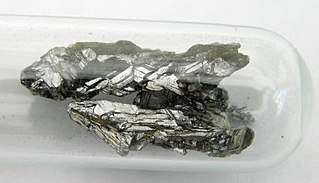
Deinococcus is one genus of three in the order Deinococcales of the bacterial phylum Deinococcus-Thermus highly resistant to environmental hazards. These bacteria have thick cell walls that give them Gram-positive stains, but they include a second membrane and so are closer in structure to Gram-negative bacteria. Deinococcus survive when their DNA is exposed to high doses of gamma and UV radiation. Whereas other bacteria change their structure in the presence of radiation, such as by forming endospores, Deinococcus tolerate it without changing their cellular form and do not retreat into a hardened structure. They are also characterized by the presence of the carotenoid pigment deinoxanthin that give them their pink color. They are usually isolated according to these two criteria.
Fictibacillus arsenicus, also known as Bacillus arsenicus, is a bacterium. It is Gram-positive, motile, endospore-forming, rod-shaped and arsenic-resistant. Its type strain is Con a/3T.
Deinococcus geothermalis is a bacterium. It produces orange-pigmented colonies and has an optimum growth temperature of about 45 °C (113 °F) to 50 °C (122 °F). It is extremely gamma radiation-resistant. Its type strain is AG-3a.
Deinococcus murrayi is a bacterium. It produces orange-pigmented colonies and has an optimum growth temperature of about 45 °C (113 °F) to 50 °C (122 °F). It is extremely gamma radiation-resistant. Its type strain is ALT-1b.
Nocardioides aquaticus is a species of Gram-positive, non-motile and aerobic bacteria. Its type strain is EL-17KT.
Friedmanniella lacustris is a species of Gram-positive, non-motile and aerobic bacteria. Its type strain is EL-17AT.
Lentibacillus salicampi is a moderately halophilic bacterium, the type species of its genus. It is Gram-variable, aerobic, endospore-forming and rod-shaped, with type strain SF-20(T).
Lentibacillus juripiscarius is an aerobic, spore-forming, Gram-positive, moderately halophilic bacteria, with type strain IS40-3T.
Marinobacter sediminum is a marine, Gram-negative, aerobic and halophilic bacteria with type strain KMM 3657T.
Saccharibacter floricola is an osmophilic acetic acid bacterium first isolated from pollen. It is Gram-negative, aerobic and rod-shaped, with type strain S-877T. It is the type species of its genus.
Microbacterium dextranolyticum is a bacterium of the family Microbacteriaceae, with type strain IFO 14592.
Microbacterium aurum is a bacterium of the family Microbacteriaceae, with type strain IFO 15204.
Desulfotomaculum halophilum is a halophilic sulfate-reducing bacterium. It is endospore-forming, long, straight to curved rod-shaped and with type strain SEBR 3139T.
Streptomyces indicus is a bacterium species from the genus of Streptomyces which has been isolated from deep sea sediments from the Indian Ocean in India.
Hymenobacter actinosclerus is a bacterium from the genus of Hymenobacter which has been isolated from pork chops.
Hymenobacter aerophilus is a Gram-negative, non-spore-forming, aerobic and rod-shaped bacterium from the genus of Hymenobacter which has been isolated from airborne from the Museo Correr in Venice in Italy.
Isoptericola halotolerans is a Gram-positive, moderately halophilic and non-motile bacterium from the genus of Isoptericola which has been isolated from soil from the Qinghai Province in China.
Isoptericola variabilis is a facultative anaerobic and nitrile-hydrolysing bacterium from the genus of Isoptericola which has been isolated from the hindgut of the termite Mastotermes darwiniensis in Germany.
Microbacterium paludicola is a Gram-positive, xylanolytic, short-rod-shaped and non-motile bacterium from the genus of Microbacterium which has been isolated from swamp forest soil from Ulsan in Korea.
Asaccharobacter celatus is a Gram-positive, non-spore-forming and obligately anaerobic bacterium from the genus of Asaccharobacter which has been isolated from a rat caecum in Japan. Asaccharobacter celatus produces equol and 5-hydroxy equol.



